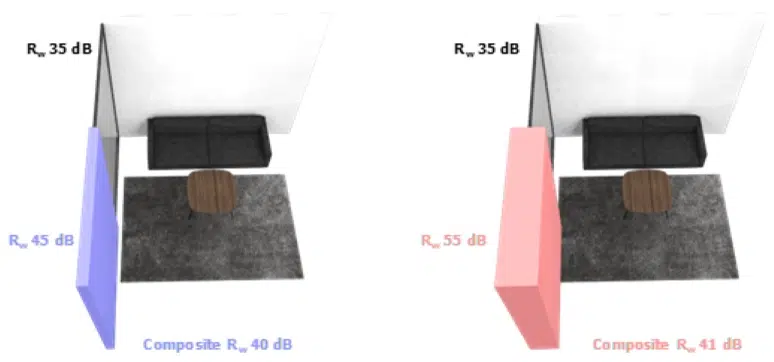As cities continue to grow, the need to mitigate external noise and enhance indoor acoustic quality has become paramount. The criteria for acoustic comfort have evolved into a necessary consideration in habitable spaces. Several studies have investigated the connection between noise annoyance and both the physical attributes of sound and its impact on health and well-being. Noise nuisance has been shown to adversely affect hypertension, increase the chances of cardiovascular diseases, increase stress, and reduce cognitive efficiency in occupants [1].
An acoustically comprehensive strategy for occupant comfort in buildings often involves a multifaceted approach, incorporating design concepts, material selection, and the expertise of acoustic consultants to achieve optimal results. However, in pursuit of streamlined green and sustainable strategies, the acoustic well-being of the users of the space often goes unnoticed. For instance, a study on indoor environmental quality (IEQ) involving 23,450 respondents from 142 buildings concludes acoustic nuisance as the primary concern in LEED-certified offices [2]. This scenario can be avoided through thoughtful consideration and a touch of creativity. It is possible to merge the objectives of sustainability and acoustics and create a facility that is both functional and sustainable.
Even in residential buildings, acoustic complaints rank among the top three dissatisfaction measures from occupant post-occupancy evaluations (POEs). Looking at the physical characteristics of sound, residents primarily express annoyance with various noise sources, including noisy neighbours, raffic, and construction. The building envelope becomes the primary form of protection for the residents from the urban soundscape. Then, the acoustic performance of a building façade is a critical aspect to consider in providing a comfortable living space for occupants.
The Acoustics in Façade Systems
The Acoustic performances of façade systems are generally given in STC, OITC, R w or R w +C tr ratings. Understanding key acoustic metrics is crucial in evaluating the acoustic performance of façades.
Sound Transmission Class (STC) is a US metric that measures the ability of a material to impede the transmission of sound. Similar in most ways to STC, the R w (weighted sound reduction index) is an International Standard Organisation (ISO) metric that assess the airborne sound insulation performance of a system. Both these rating usually provide similar numbers given there are no substantial peaks or troughs in the transmission loss (TL) spectrum.
However, when specifying façade acoustic criteria, it is important to consider the extended frequency performance of the system for appropriate design.
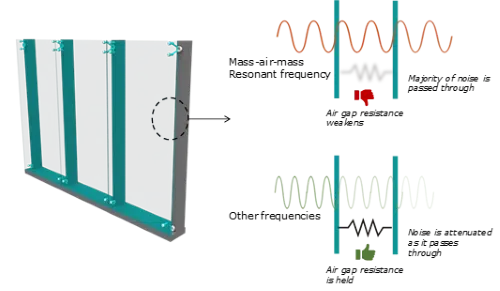
The outdoor-indoor transmission class (OITC) rating was created in the late 1980’s within ASTM as a standard classification in response to a perceived need for a more robust metric that adequately considers low-frequency incident sound. The OITC is usually 5 to 10 dB lower than STC. This type of noise is dominant near highways, airports, or mechanical plants. The International Standard Organisation (ISO) also provides a similar single-number rating denoted as R w +C tr . The C tr is an additional spectrum correction that focuses on low frequencies, primarily transport and industrial noise.
All these metrics are laboratory-measured indices that are tested under controlled conditions. In most cases, a reduction in the range of 5-10 decibel points can be observed between lab and on-site test measurements, primarily due to flanking paths and quality of workmanship on-site.
Significance of an Air Gap
Glazing build-up is one of the key properties that determines the performance of a glazed façade system. As glass is a stiff limp mass, they tend to follow the ‘mass law’ where the sound insulation performance of a system is directly proportional to its mass per unit area. Doubling the airgap is expected to give an improvement of around 3 points in R w /STC rating.
For a specific frequency, the air gap tends to reduce the performance of the system due to the ‘Mass-Air-Mass resonance’ effect. In this frequency, the air will effectively act as a spring that will easily transfer noise. One of the ways to adjust this dip in performance is to increase the air gap, which tends to move this dip towards the low frequencies, away from the sensitive audible spectrum.
Different Glazing Thickness? Is It Better?
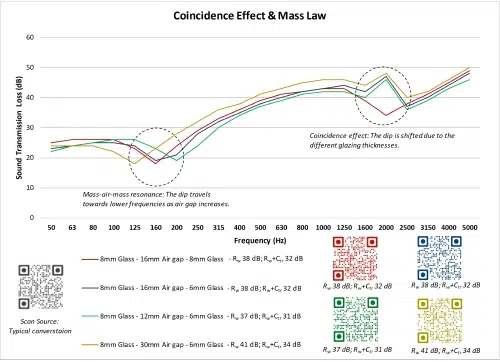
The materials used in the façade system, such as glass and aluminium, possess an inherent ability to vibrate at specific frequencies referred to as their ‘natural frequency’ or ‘coincidence frequency’. For glazing systems, this frequency depends on the nature of the glass, its dimension, its fittings and installation. Noise impinging on the glazing at their natural frequency range will pass through with little attenuation and will form a dip in their acoustic performance spectrum. This is known as the ‘coincidence effect’.
The coincidence effect is of particular concern since the coincidence frequency of glass usually corresponds with the nature of high-frequency noise from traffic, aircraft, etc. If not designed appropriately, these noises can be heard through the façade system. Opting for varying glass thickness in a double-glazed system can remedy this effect to a considerable level. This will ensure that the transmission loss is flattened and spread to not occur drastically over a specific frequency.
These effects discussed above can be observed in Figure 2, along with QR codes to scan for audio files. A difference of 3 decibel points is rarely perceivable, and the sensitivity of people varies. These audio files are provided to try to find some perceived difference in level drop from a source and also if possible any frequency response differences between the systems by the listener.
To Laminate, or Not to Laminate, That is the Question
A laminated glass is a type of safety glass composed of two or more layers of glass bonded together with a transparent and flexible interlayer, typically made of polyvinyl butyral (PVB). An improvement of 1-3 points is generally expected from a typical PVB laminate system depending on the number of layers between the glass.
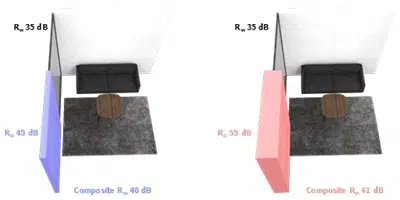
Furthermore, specific laminates focused on sound insulation capabilities are also developed by various glazing manufacturers that can offer an improvement of at least 3 dB or more from just a single layer of laminate & can also have specific transmission control over frequency ranges. Due to their unique nature, they are relatively expensive and are used only in specific situations if necessary. The inclusion of lamination in a glazed façade also changes its visual essence depending on the lamination thickness.
Although not as critical as a Shakespearean dilemma as the title suggests, the selection and inclusion of laminated glass in the façade requires some thought. A well-coordinated strategy with the acoustic consultant and the design team is required when prescribing laminated glazing systems. The solution should ideally maintain the visual uniformity and architectural design intent of the façade.
The Composite Performance
The performance of a building façade is usually determined by multiple elements, including glazing, walls, windows, spandrels, and other similar components. In a composite façade, the overall acoustic performance of the system is effectively determined by its acoustically weakest insulating element. In a scenario for a room where, if around 30% of a façade area is glazing with R w /STC 35 dB performance and the remaining is blockwork of R w /STC 45 dB, the composite performance will effectively be around R w /STC 40 dB. You may expect a 1-2 point improvement by increasing the blockwork acoustic performance, but nothing more.
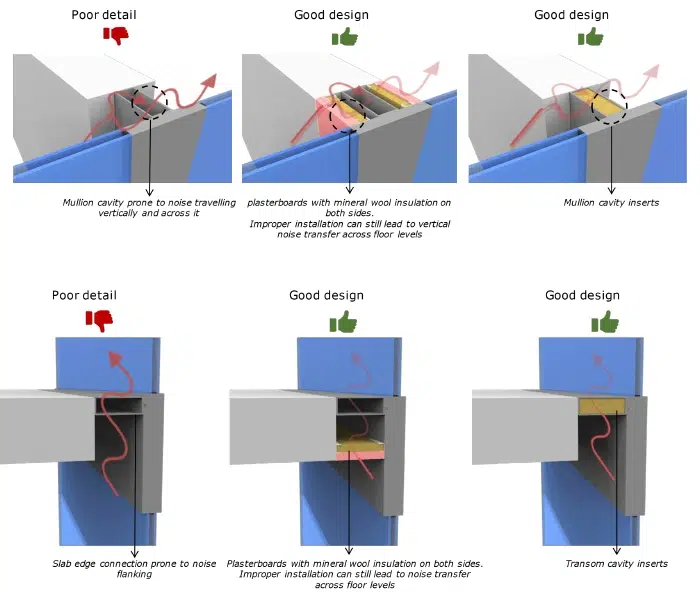
In reality, given the weakest element covers around 10% to 40% of the total façade area, increasing the performance of surrounding elements by 10-decibel points or more than the weakest element’s acoustic performance provides little to no improvement in the composite performance of the façade.
A façade system specimen presented for an acoustic test must include all fittings and frames exactly as how it would be constructed on-site. Separate tests of individual façade elements will not confirm Figure 3: Illustration showing effect on a composite rating from different element performance the performance of the composite façade system. If individual performances and dimensions are known, an estimated performance can be calculated using the methodology provided in BS 8233. However, this cannot validate the composite system’s performance instead of a certified acoustic laboratory test.
Flanking in Façades – The Achilles Heel
Flanking is the transmission of sound through alternate paths or unintended routes due to improper detailing or on-site conditions. Any fittings or fenestrations on the façade can bring down the performance of a façade drastically due to flanking even if the glazing is of superior performance.
In high-rise curtain wall systems, the usual points of flanking are through mullion cavities, slab edge connections, spandrel points, cladding cavities, etc.
The first step is to identify possible flanking paths over a section detail and provide an acoustic block to the path, typically using a few layers of plasterboards & some mineral wool between cavities. This may not be a suitable option in all cases, as they may not align with the design intent. Another solution is to provide cavity inserts in the mullions or transoms between spaces. This application has its drawbacks when considering the complexity and labour involved in actualising this on-site or otherwise. Some illustrations are provided to show possible flanking paths and good design practices to treat them.
The perimeter seals, jambs, drop seals, cavity fillers, etc that are involved in the installation and workmanship of fenestration can impact the overall performance of a building façade greatly. Applying foam, sealants, or other materials to fill gaps between the window frame and the rough opening has the potential to effectively reduce sound transmission to a satisfactory level. ASTM C919 focuses on the critical task of sealing small gaps between material interfaces to reduce the ease of sound transmission. The presence of a “hiss” noise or a dip in the mid to high-frequency range through the façade generally indicates poor sealing around the system.
Conclusion
Façade acoustics is essentially a balance of design engineering, material quality, workmanship, and acoustic expertise. Collaboration between architects, façade engineers, and acoustic consultants is essential to achieve a harmonious balance between aesthetic appeal and optimal acoustic performance of façades. By incorporating sound insulation strategies from the conceptual stage, designers can create buildings that not only stand as architectural marvels but also provide a quiet and comfortable sanctuary amidst the urban jungles.
References
- E. B. E. O. L Barregard, “Risk of hypertension from exposure to road traffic noise in a population-based sample,” Occup Environ Med, vol. 66, no. 6, pp. 410-5, June 2009.
- C. Curtland, “Acoustics: The Biggest Complaint in LEED-Certified Office Buildings,” Buildings, 21 August 2012.
